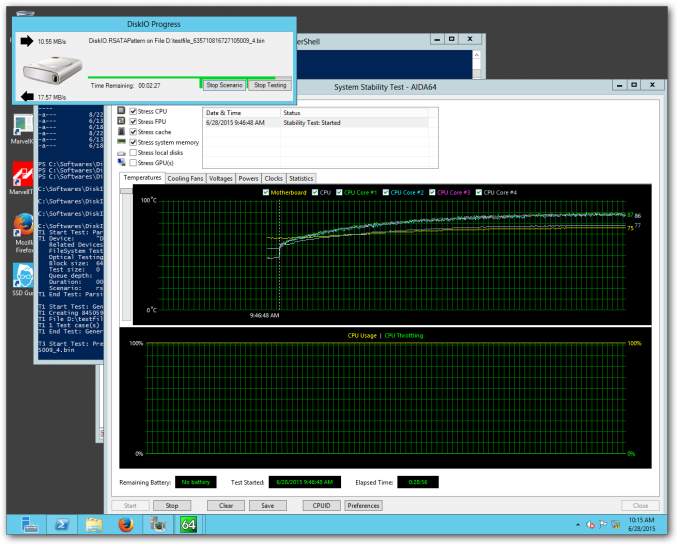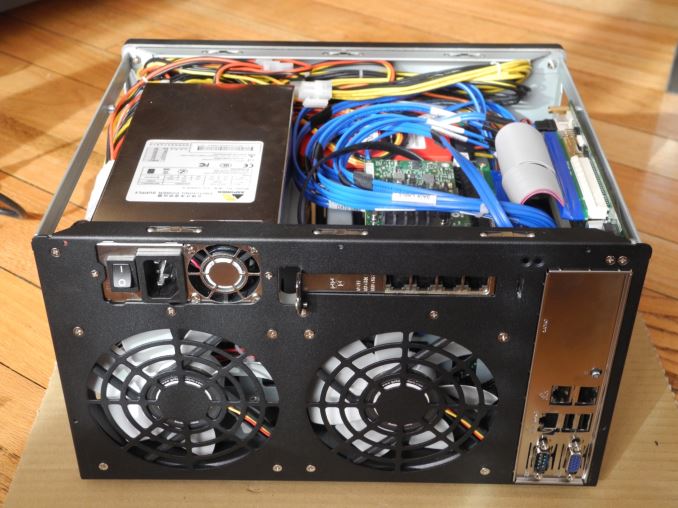ASRock Rack C2750D4I and U-NAS NSC-800: A DIY File Server
by Ganesh T S on August 10, 2015 8:45 AM EST- Posted in
- NAS
- storage server
- Avoton
- ASRock Rack
- U-NAS
Miscellaneous Aspects and Concluding Remarks
Low power consumption and the ability to keep the drives cool under stress are some of the desirable characteristics of file servers. In order to evaluate this aspect, we subject the system with Windows Storage Server 2012 R2 to a stability test using AIDA64. For stressing the disks (storage spaces volume using the drive bays), we used Microsoft's DiskIO with the pre-defined worst-case SATA patterns issued randomly with verification.
We find that the CPU doesn't throttle and the cores stabilize around 87 C, with the motherboard at 75 C. During this process, we also recorded power consumption at the wall. We found that the maximum power consumption was around 70 W, while the idling power consumption was around 38 W.
The ASRock Rack C2750D4I with the U-NAS NSC-800 is the first of three file servers that we have evaluated with Ubuntu 14.04 and Windows Storage Server 2012 R2. While the Phoronix Test Suite benchmarks have been chosen for their relevant to file server workloads, it appears that the SPEC SFS 2014 benchmarks do not bring out what people use the Storage Spaces feature for. We are still optimizing the testbed for SPEC SFS 2014, and we do have plans to evaluate other NAS OSes used in DIY builds using the same approach.
Coming to the business end of the review, we have two things to discuss. The ASRock Rack C2750D4I is almost the ideal motherboard for power users wanting to build a dedicated low-power file server or NAS. Native USB 3.0 support would have been nice, but a add-on card solution is not a bad one for those desiring high-speed external I/O. Other than that, there is not much to complain - The layout of the motherboard's SATA ports ensure that most of the disks can talk at full speed to the Avoton SoC. This becomes an issue only if one decides to take maximum advantage by utilizing all the SATA ports on the board. However, in our evaluation scenario, as the platform for a 8-bay file server, it fit in perfectly.
This brings us to the second aspect - the 8-bay U-NAS NSC-800. There are plenty of storage-focused chassis designs to choose from. In fact, the Silverstone DS380 is an excellent choice for those looking to install the motherboard in a flexible system. On the other hand, the NSC-800 brings in the compactness factor into the equation. Simply put, it is not possible to get a 8-bay NAS chassis smaller than the NSC-800. Any smaller, and a mini-ITX board with a single-slot PCIe card is not going to fit in. Even though U-NAS tries its best to make cabling easier by providing the SATA cables in a bundle from the backplane, installing the motherboard in such a cramped space is definitely a challenge.
The build presented in this review has a diskless cost of around USD 845 - a completely reasonable number given that the unit contains 8GB of ECC RAM. A look at the prices of commercial off-the-shelf diskless file servers based on Avoton make the DIY approach very attractive.












48 Comments
View All Comments
damianrobertjones - Monday, August 10, 2015 - link
Any chance of adding the price to the top of the page? I can then evaluate suitability etc.SirGCal - Monday, August 10, 2015 - link
I saw it a few times throughout the article including the top page. $845colinstu - Monday, August 10, 2015 - link
What's with the benchmarks that aren't compared to anything else?ganeshts - Monday, August 10, 2015 - link
This is the first of three file servers that we are reviewing with a completely new evaluation methodology. Since we are just starting out, there are no comparison numbers, but I do link to OpenBenchmarking.org pages for each of the tests - so one can see what other systems are capable of with respect to that benchmark.DanNeely - Monday, August 10, 2015 - link
I think U-NAS deserves more credit for the compactness of their case designs. Being much bulkier than units from Synology/etc has always been an issue for anyone in a space constrained situation (or just with a spouse who grumbles about how much space all of your toys takes up). This case is only 15% larger in volume than Synologies DS1815+ (12.4 vs 14.4 liters); and their 4 bay model comes even closer to the DS414 (7.8 vs 8.7l).Assuming I decide on a DIY box to replace my WHS2011 box in a few months, the U-NAS NSC-400 is exactly what I'm looking for in a chassis (and half the size of the box it'd be replacing).
xicaque - Monday, November 23, 2015 - link
I have built two of these units. I am very happy with them. for 200bucks (case only with some wires) is not a bad deal. I am running freenas.DanNeely - Monday, August 10, 2015 - link
Do you have any power consumption numbers available?Johnmcl7 - Monday, August 10, 2015 - link
There are some power figures on the last page, 70W under load and 38W idle.DanNeely - Monday, August 10, 2015 - link
two numbers in the text is a far cry from the normal table showing rebuild times and power levels shown in a normal NAS review.ganeshts - Monday, August 10, 2015 - link
Dan, Yes, it felt a bit odd for me to leave out that table in a NAS review.. The issue for me is that it is not worth it to spend more than 'N' hours on evaluating a particular system / review a particular product, and setting up the SPEC SFS 2014 benchmarks and processing it took a lot of time.I hope to address this issue in future file server reviews (now that SPEC SFS 2014 seems to be stable), but not for the next two (which have already been evaluated and are just pending write-up)